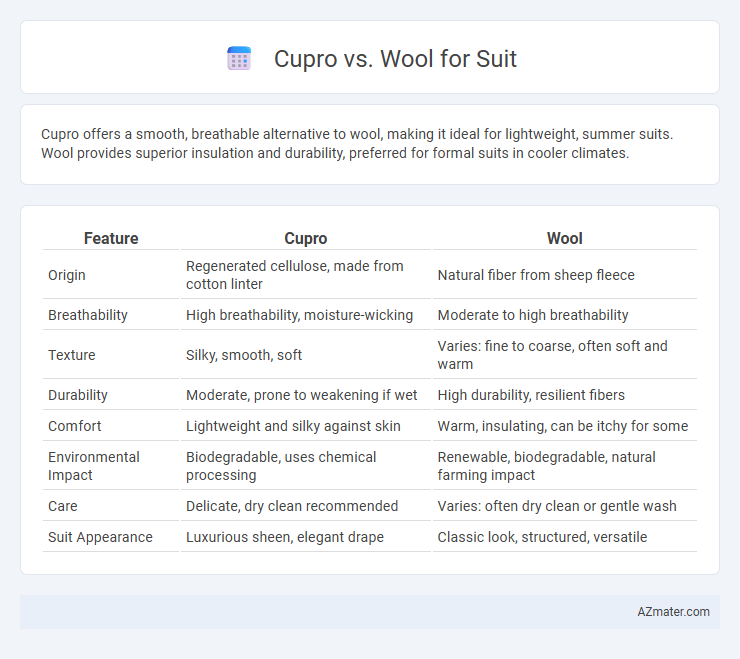Cupro offers a smooth, breathable alternative to wool, making it ideal for lightweight, summer suits. Wool provides superior insulation and durability, preferred for formal suits in cooler climates.
Table of Comparison
| Feature | Cupro | Wool |
|---|---|---|
| Origin | Regenerated cellulose, made from cotton linter | Natural fiber from sheep fleece |
| Breathability | High breathability, moisture-wicking | Moderate to high breathability |
| Texture | Silky, smooth, soft | Varies: fine to coarse, often soft and warm |
| Durability | Moderate, prone to weakening if wet | High durability, resilient fibers |
| Comfort | Lightweight and silky against skin | Warm, insulating, can be itchy for some |
| Environmental Impact | Biodegradable, uses chemical processing | Renewable, biodegradable, natural farming impact |
| Care | Delicate, dry clean recommended | Varies: often dry clean or gentle wash |
| Suit Appearance | Luxurious sheen, elegant drape | Classic look, structured, versatile |
Introduction: Cupro vs Wool for Suits
Cupro, a regenerated cellulose fiber derived from cotton linter, offers a smooth, breathable, and lightweight alternative to traditional wool in suits. Wool, known for its natural insulation, moisture-wicking properties, and durability, remains a classic choice for tailored garments with superior warmth and resilience. Choosing between cupro and wool for suits depends on factors like climate, comfort preferences, and occasion, balancing breathability against insulation.
What is Cupro?
Cupro is a regenerated cellulose fiber made from cotton linter, valued for its silky texture and breathability, making it a popular choice for suit linings and lightweight garments. Unlike wool, which is derived from animal hair, cupro offers hypoallergenic properties and a smooth, cool feel against the skin. Its moisture-wicking ability enhances comfort, especially in warm climates, setting it apart from traditional wool suits.
What is Wool?
Wool is a natural fiber harvested from sheep, prized for its durability, breathability, and natural insulation, making it ideal for suits that require both comfort and structure. Its moisture-wicking properties help regulate body temperature, ensuring wearers remain dry and comfortable throughout the day. Wool fibers are resilient, wrinkle-resistant, and have excellent breathability compared to synthetic fabrics like cupro, which is a regenerated cellulose fiber derived from cotton linter often used as a silk alternative in suit linings.
Fabric Characteristics: Cupro vs Wool
Cupro fabric, made from regenerated cellulose fibers, offers a smooth, silky texture with excellent breathability and moisture-wicking properties, making it a lightweight and comfortable option for suits. Wool, derived from sheep's fleece, is naturally insulating and durable, providing superior warmth, wrinkle resistance, and elasticity, ideal for year-round wear, especially in cooler climates. While Cupro excels in softness and sheen, Wool's resilience and temperature regulation contribute to its longstanding preference in high-quality suiting fabrics.
Comfort and Breathability Comparison
Cupro suits offer exceptional breathability due to their natural fiber origin and moisture-wicking properties, making them highly comfortable in warm weather. Wool suits provide superior insulation and temperature regulation while maintaining breathability, ideal for year-round wear with added softness in finer weaves. Both fabrics balance comfort and airflow, but cupro excels in lightweight breathability whereas wool delivers versatile thermal comfort.
Durability and Longevity
Cupro fabric offers moderate durability but is prone to wear and tear over time, making it less suitable for long-term use compared to wool. Wool suits excel in longevity due to their natural resilience, resistance to wrinkles, and ability to maintain shape through repeated wear. High-quality wool fibers provide enhanced durability, ensuring suits remain tailored and presentable for many years.
Care and Maintenance
Cupro suits require gentle hand washing or dry cleaning to maintain their smooth texture and prevent fabric damage, while wool suits benefit from regular brushing and airing out to preserve their natural fibers and reduce odors. Cupro's moisture-wicking properties make it easier to clean spills, whereas wool's durability allows for occasional spot cleaning without compromising fabric integrity. Proper storage in breathable garment bags is essential for both materials to avoid mildew and extend the lifespan of the suit.
Sustainability and Environmental Impact
Cupro, a regenerated cellulose fiber made from cotton linter, offers a more sustainable choice than traditional wool by utilizing agricultural waste and requiring less water and pesticides during production. Wool, while biodegradable and renewable, often involves higher greenhouse gas emissions and extensive land use due to sheep farming. Choosing Cupro suits supports eco-friendly practices by reducing reliance on animal agriculture and promoting circular textile economies.
Price and Availability
Cupro suits generally offer a more affordable price point compared to wool, making them accessible for budget-conscious consumers. Wool suits are typically higher in cost due to the natural fiber's durability, insulation properties, and traditional appeal in formal wear. Cupro is widely available in fast fashion and mid-range brands, while wool suits are predominantly found in premium and bespoke tailoring markets.
Choosing the Right Fabric: Cupro or Wool?
Cupro offers a smooth, breathable texture ideal for lightweight, moisture-wicking suits, while wool provides superior warmth, durability, and natural wrinkle resistance, making it perfect for colder climates and formal occasions. Choosing between Cupro and wool depends on climate, comfort preferences, and suit formality, with Cupro excelling in hot weather and wool dominating in classic, year-round versatility. Wool suits deliver better insulation and longevity, whereas Cupro suits offer luxurious softness and enhanced ventilation for comfortable wear.

Infographic: Cupro vs Wool for Suit
 azmater.com
azmater.com